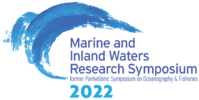Instructions for authors
Prepare your contribution according to the instructions given in the following template file:
TITLE OF THE PAPER – TIMES NEW ROMAN, BOLD, 12 DPI, JUSTIFICATION LEFT
Author A.1, Author B.2, Author C.1 and Author D.3 – Times New Roman, 11dpi bold, justification left
1 Institute of Oceanography, Hellenic Centre for Marine Research (HCMR), 46.7 km Athens-Sounion, author1@hcmr.gr, – Times New Roman, 10dpi, italics, justification left
2 Institute of Marine Biological Resources and Inland Waters, Hellenic Centre for Marine Research (HCMR), authord@hcmr.gr,
Etc.
Abstract (Times New Roman, 11dpi bold)
Times New Roman, 10 dpi, justification right-left. Abstract should not exceed 200 words. It should give the reader a brief overview of the aim of the paper, the methodology used, the main results and conclusions.
Keywords (Times New Roman, 10dpi bold): Two to five representative words, not included in the title (preferably from the ASFA database Thesaurus) Times New Roman, 10dpi.
1. Introduction (Times New Roman, 11dpi bold)
Text in Times New Roman, 11 dpi, Α4 page format, right-left margins 2cm, up 3.5cm, bottom 2.5cm, single spacing. This model represents the final form of the accepted paper to be presented in the Marine & Inland Waters Research Symposium 2021.
2. Material and Methods (Times New Roman, 11dpi bold)
Papers should be written in MS/Word format and not more than four (4) pages.
2.1 sub-section title in Times New Roman, 11dpi, italics
Table 1. Table caption should be placed above the table, in 10dpi Times New Roman font, text justified.
Fig. 1: Figure caption should be placed below the figure, in 10dpi Times New Roman font, text justified.
Figures and Tables should be numbered consecutively as they appear in the text. Figures and Tables should not be larger than the page margins and saved in jpg or tif format, 300 dpi.
Genus and Species names should be in italics
The authors should follow the latest I.C.B.N. & I.C.Z.N. taxonomy or consult the WoRMS web site.
Equations and units
Use standard SI units. Variables are usually in Italics. Italicization should be consistent throughout the text. Leave one blank space on either side of ‘=’, ‘>’, ‘±’, etc.
3. Results (Times New Roman, 11dpi bold)
4. Discussion/Conclusion (Times New Roman, 11dpi bold)
5. Acknowledgements (Times New Roman, 11dpi bold)
The authors should acknowledge the source of funding of the research as well as the assistance of individuals or organizations not identified in the list of authors.
6. References (Times New Roman, 10dpi bold)
References should be in Times New Roman, lowercase, 10dpi, fully justified, first line hanging 0,5 cm, in alphabetical order, no numbering.
Please ensure that all the citations written in the text are included in the list, and that the dates and authors given in the text match those in the references list. Citations in the text should be identified by means of an author’s name followed by the year of publication (Author, 2011). When there are two authors, both names should be mentioned and separated by ‘&’ (Author 1 & Author 2, 2009). When there are three or more authors, only the name of the first author should be mentioned, followed by ‘et al.’ in Italics and the year of publication (Author 1 et al., 2012). If a cited author has published two or more papers in the same year, the references, both in the text and the references list, should be identified by a lower-case letter, such as ‘a’ and ‘b’ after the date (Author, 2006a, b). Semicolons should separate more than one citation, which should be in chronological order (from the earliest to the latest) (Author-A, 2005; Author-B & Author-C, 2010a, b; Author-D et al., 2012.)
The authors should use the following styles for the references list (https://ejournals.epublishing.ekt.gr/index.php/hcmr-med-mar-sc/about/submissions#authorGuidelines):
Regular journal articles (Should the number of authors exceed five (5), then only the first five should be given, followed by et al.)
Lemee, R., Pesando, D., Issanchou, C., Amade, P., 1997. Microalgae: a model to investigate the ecotoxicity of the green alga Caulerpa taxifolia from the Mediterranean Sea. Marine Environmental Research, 44 (1), 13-25.
Books (authored)
Zenetos, A., Gofas, S., Russo, G., Templado, J., 2004. CIESM atlas of exotic species in the Mediterranean. Vol.3. Molluscs. CIESM Publishers, Monaco, 376 pp.
Books (edited)
Thompson, W.L. (Ed.), 2004. Sampling rare or elusive species: concepts, designs, and techniques for estimating population parameters. Island Press, Washington, DC, 429 pp.
Book chapters
Occhipinti-Amborgi, A., 2002. Current status of aquatic introductions in Italy. p. 311-324. In: Invasive Aquatic species of Europe – distribution impacts and management. Leppakoski, E., Gollasch, S., Olenin, S. (Eds). Kluwer Academic Publishers, London.
Theses
Méliane, I., 2002. Contribution to the knowledge of the ascidian fauna in the south east of Tunisia. MSc Thesis. University of Alicante, Spain, 65 pp.
Conference papers
Katsanevakis, S., Thessalou-Legaki, M., 2009. Documenting the presence of protected species in Souda Bay. p. 745-750. In: 9th Panhellenic Symposium of Oceanography & Fisheries, Patra, 13-16 May 2009. HCMR, Athens.
Reports
Smeets, E., Weterings, R., 1999. Environmental indicators: Typology and overview. European Environment Agency (EEA), EEA Technical report, No 25, 19 pp.
European Official Documents
EU, 2000. Directive 2000/60/EC of the European Parliament and of the Council of 23 October 2000 establishing a framework for Community action in the field of water policy. Official Journal of the European Communities L327, 1-72.
Websites
ELNAIS, 2012. Ellenic Network of Aquatic Invasive Species. https://services.ath.hcmr.gr (Accessed 7 February 2012)
Froese, F., Pauly, D., 2009. Fish Base. http://www.fishbase.org (Accessed 18 August 2012)
